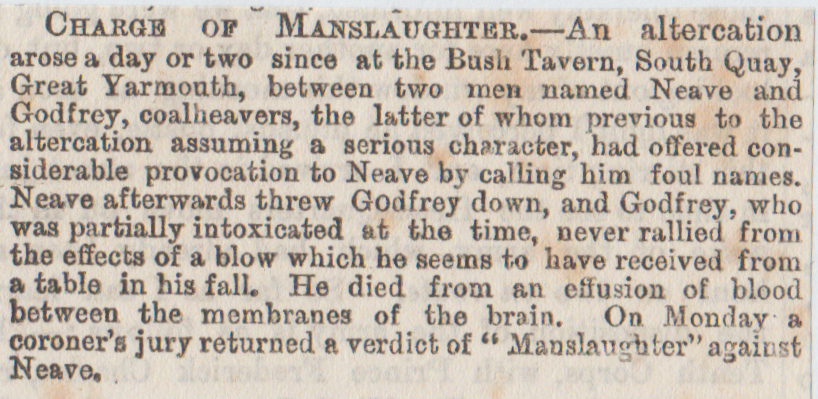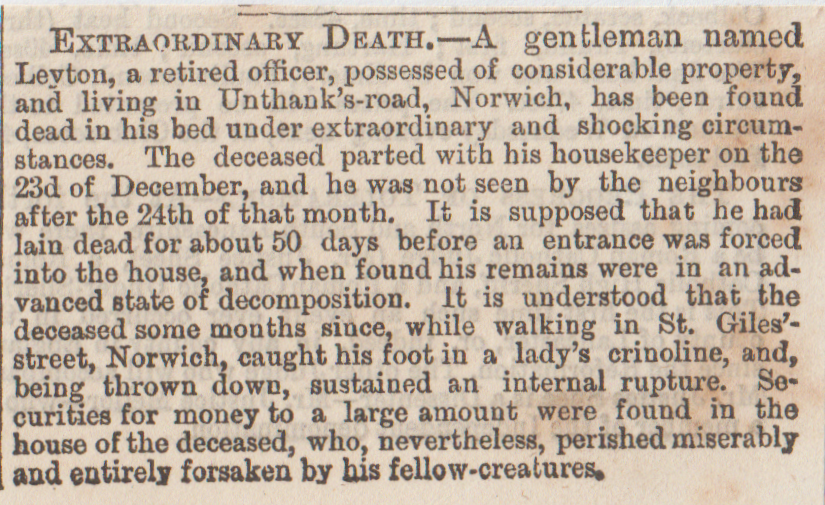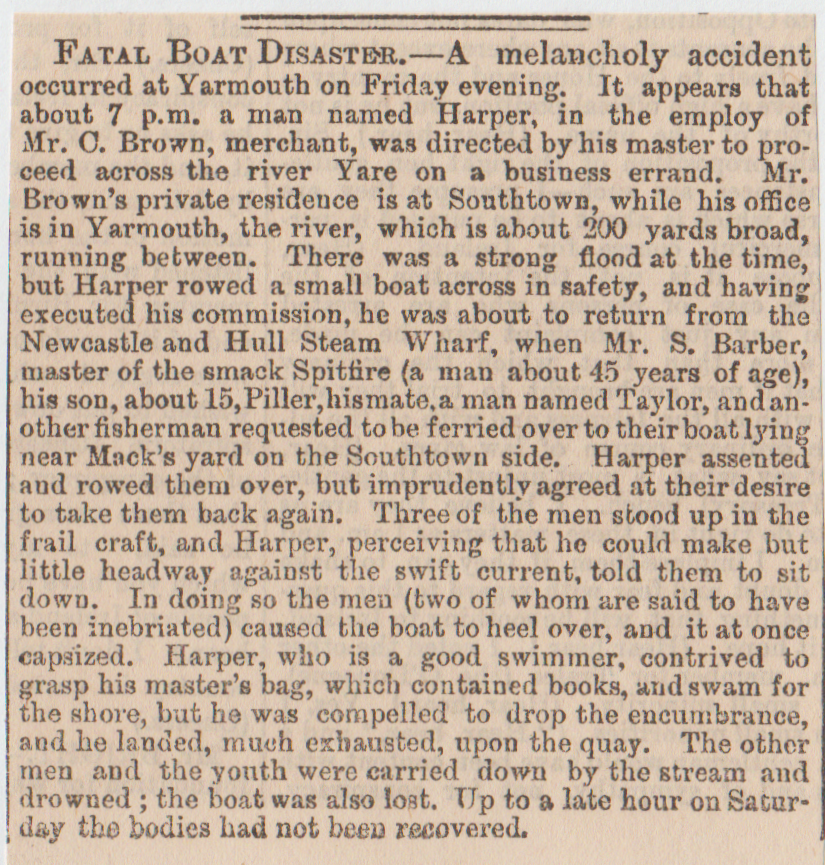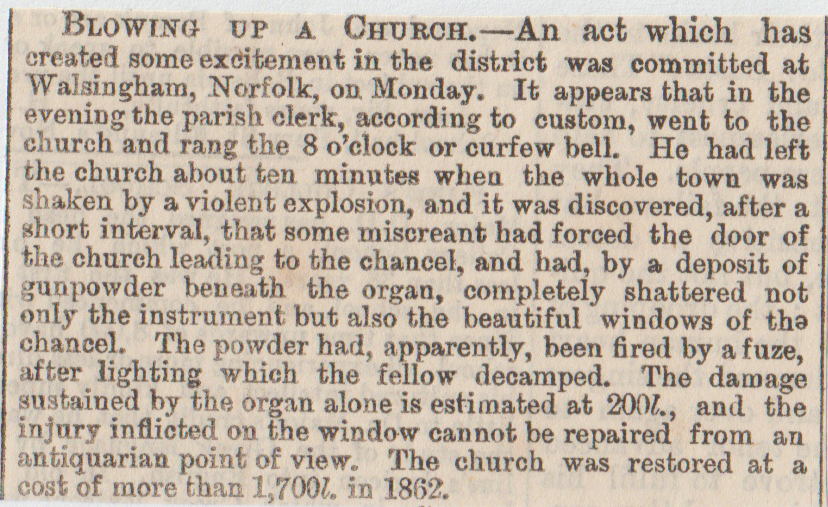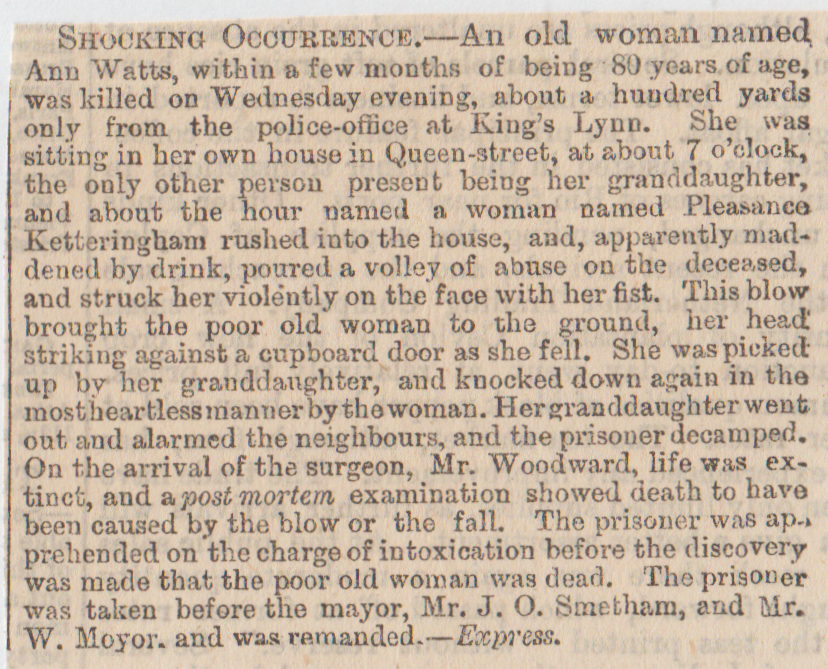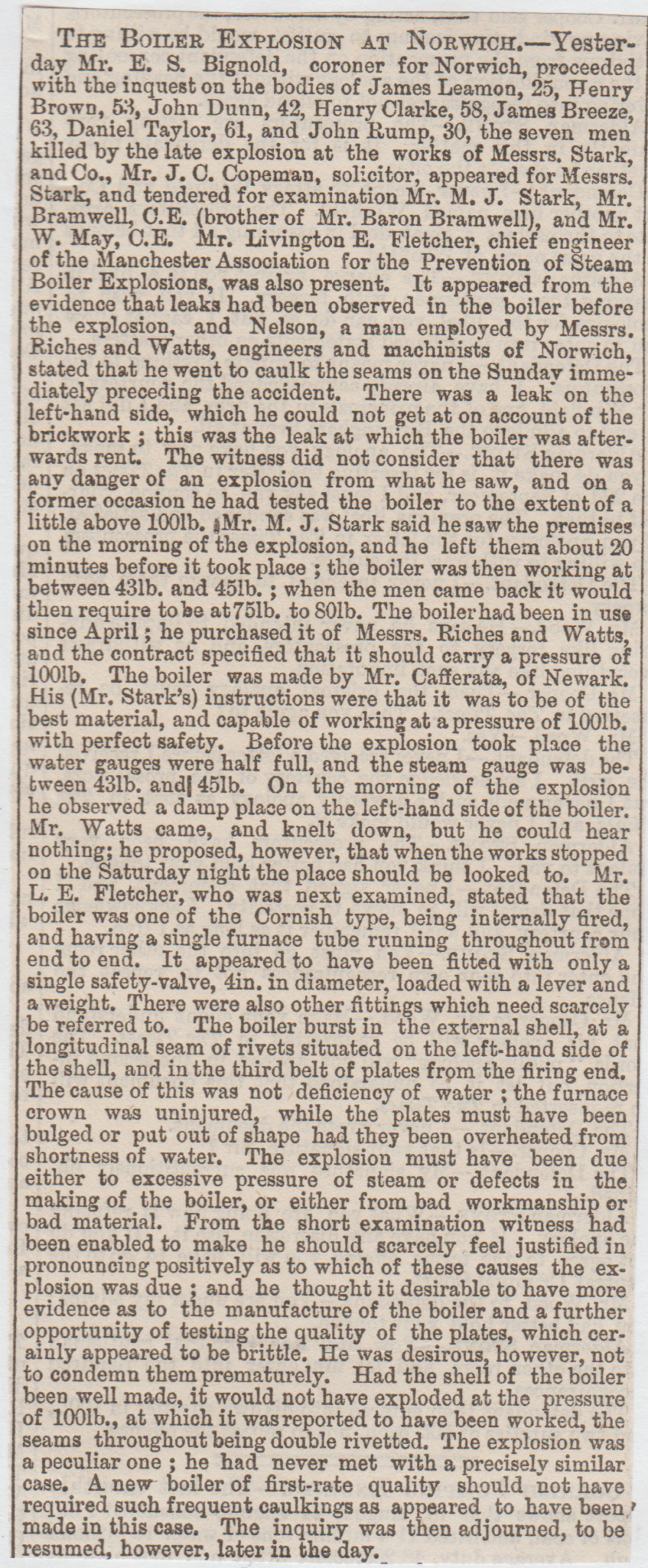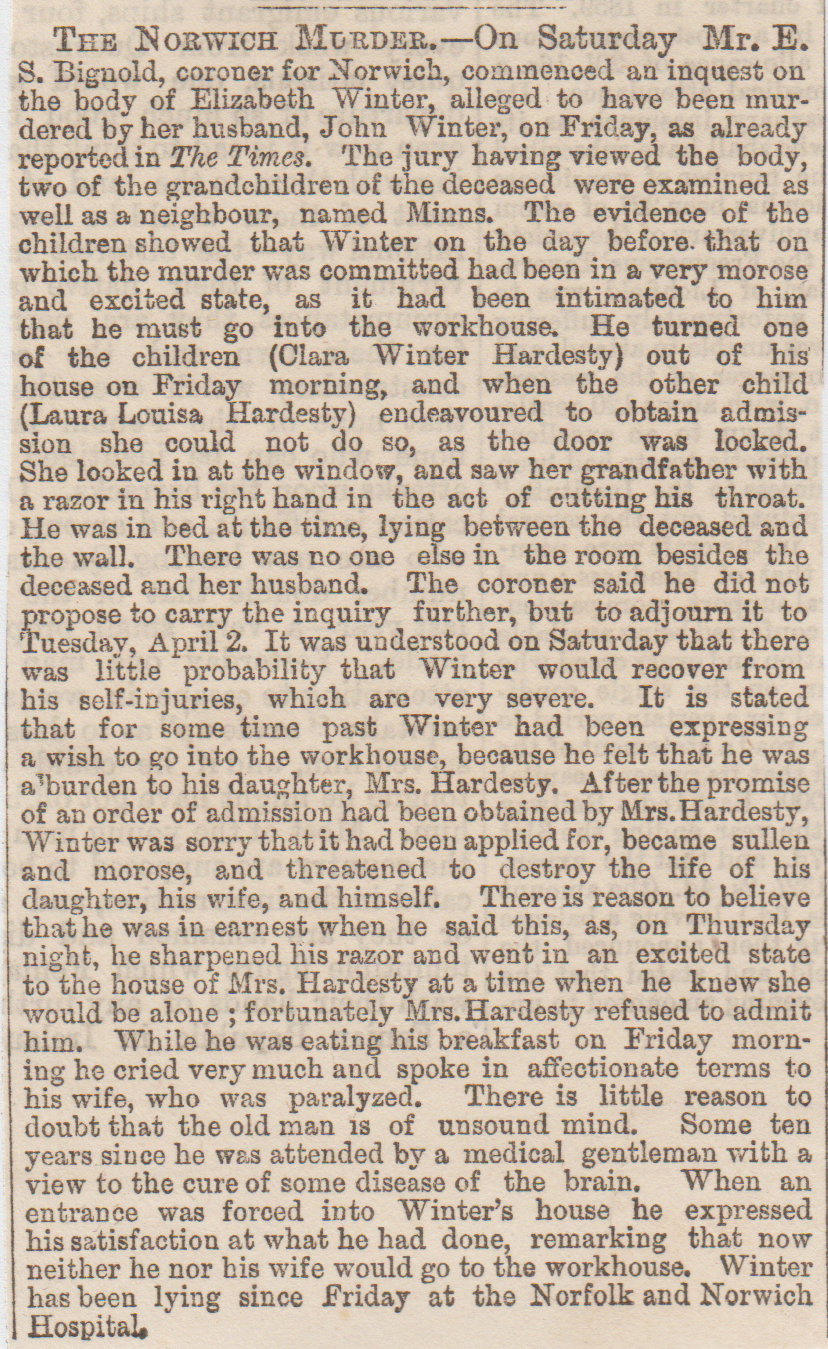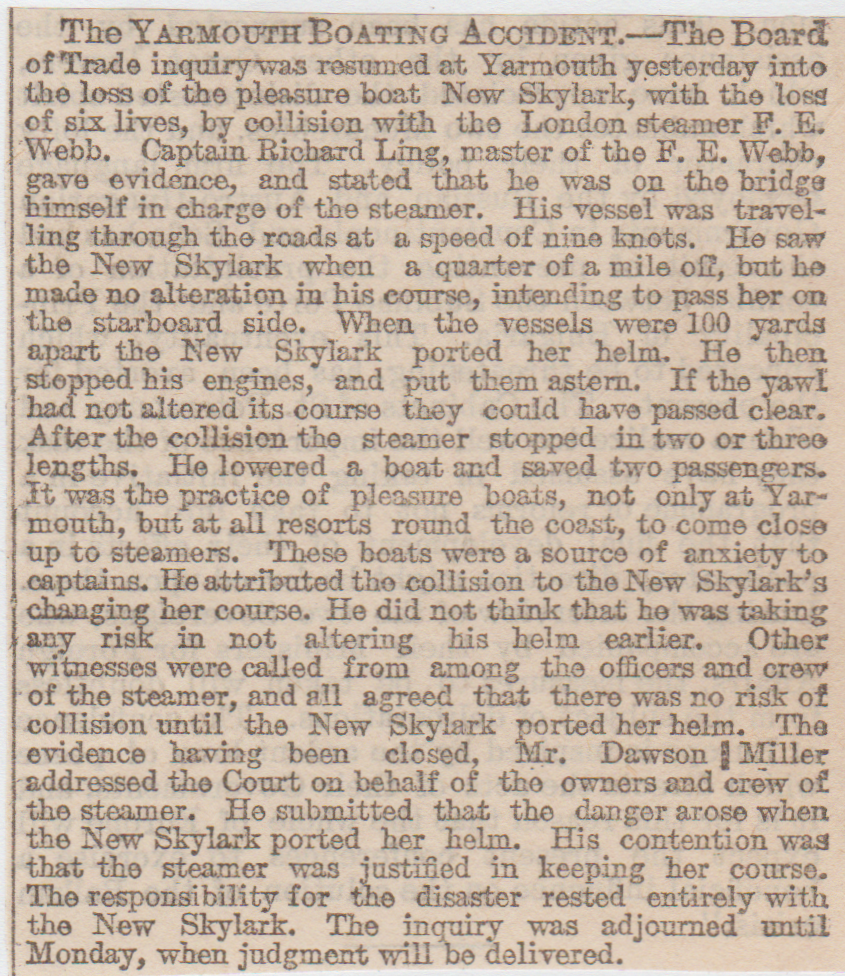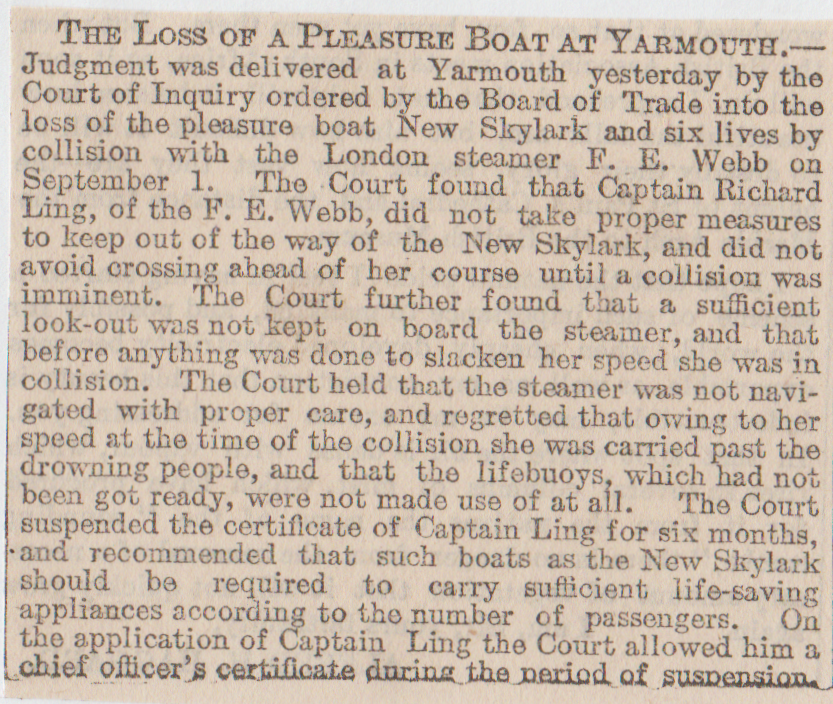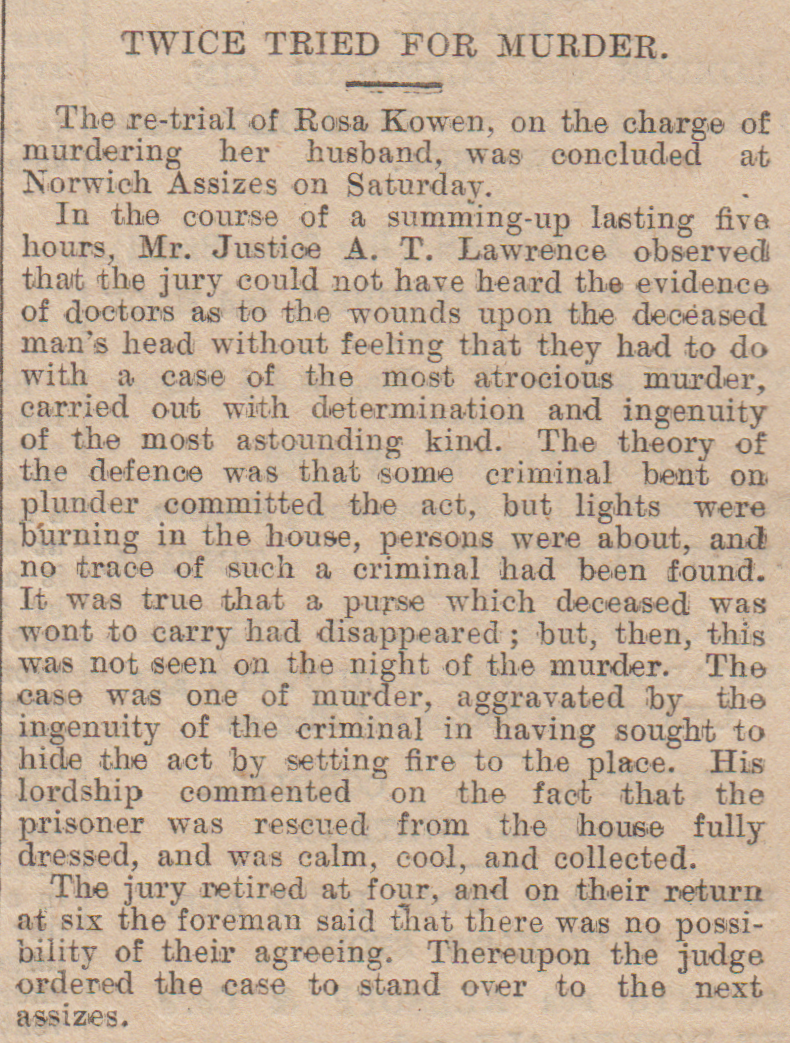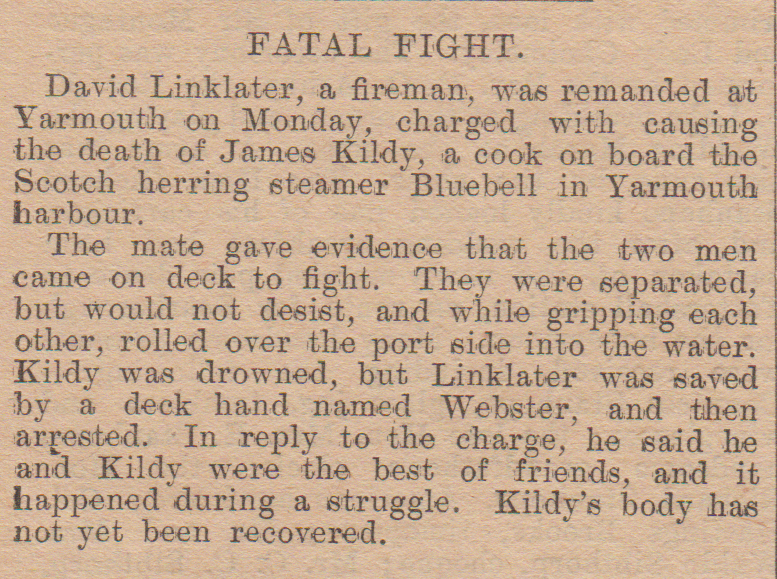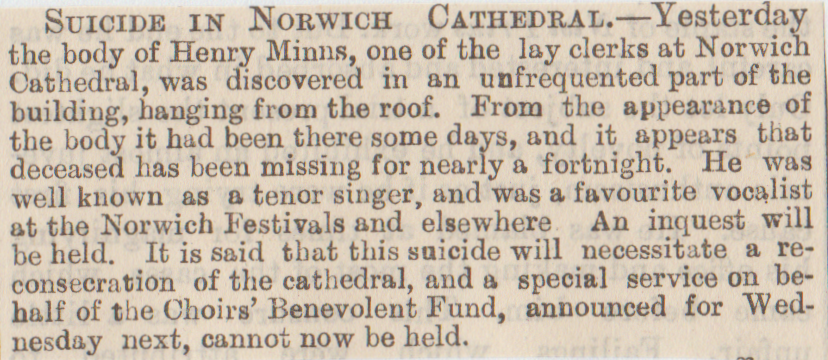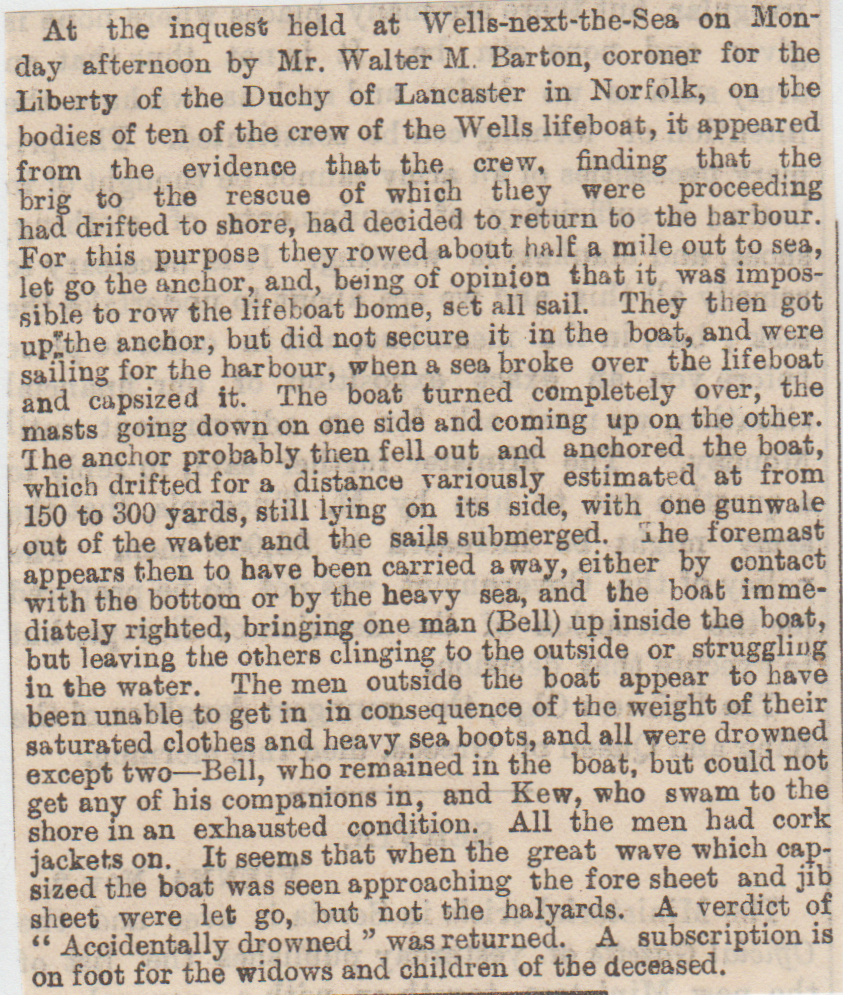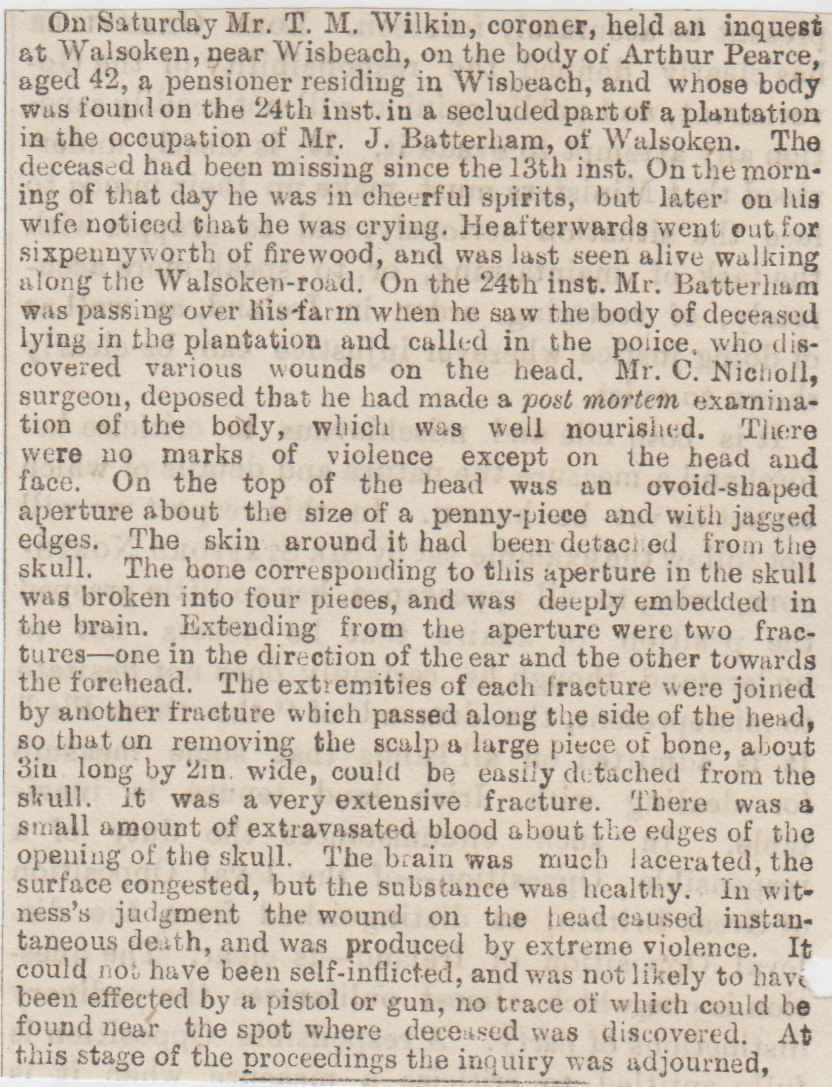1/ Crostwick Witch, July 1883
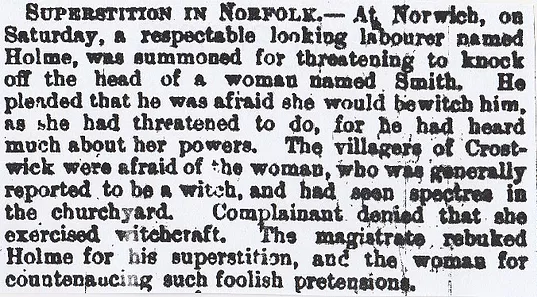
2/ Gurney’s Bank Suicide, Norwich, February 1893
William Wright, a Norfolk farmer, went with his nephew to Gurney’s Bank in Norwich. While the nephew was counting the bank slips, Wright cut his throat with a penknife. He was rushed to Norfolk and Norwich General but died after a few hours. There were about fifty customers, it was the peak time for transactions, so it beggars the question, why there and then?
3/ South Beach, Great Yarmouth, September 1900 (Body on the Beach)
A bathing attendant found the body of a gorgeous young lady on the beach at Yarmouth. She had a boot-lace wrapped around her throat, in a sort of garotte. Information gleaned about her is that she had come here a week ago from London and she also had a child with her. She went by the name of Mrs Hood, told hotel staff she was a widow and twenty-seven years old. Letters found, suggest that she has friends in Woolwich. (Murder or Suicide?/Was she Mrs Hood?)
4/ Kings Lynn Suicide, November 1893
Short, sharp and sweet. (I put it in for the name) Frederick Smoothly a retired butcher, shot himself in King’s Lynn. He was well-known in Cambridgeshire and Norfolk.
5/ Yarmouth/North Sea, January 1877 (Six Fishermen Drowned)
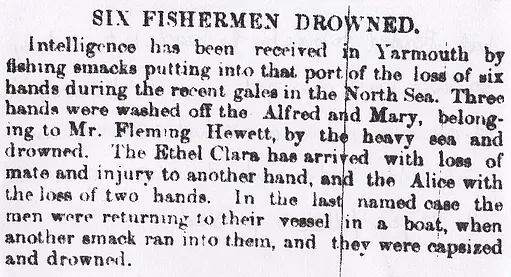
6/ Great Yarmouth, April 1899
Another instance of a husband and wife dying on the same day is reported from Yarmouth, where the bodies of an aged couple named Revell and who now await burial. The husband died suddenly during the morning from influenza and the discovery of his body gave his wife such a shock, that she died the same afternoon.
7/ Kings Lynn Manslaughter, December 1885
At Kings Lynn on Thursday, Robert Cozens aged twenty-five years was committed for trial at Ipswich Assizes charged with the manslaughter of Mary Jane Chilvers, a woman with whom he lived, by striking her in the face with his fist.
8/ South Town Station Death, Yarmouth, August 1890
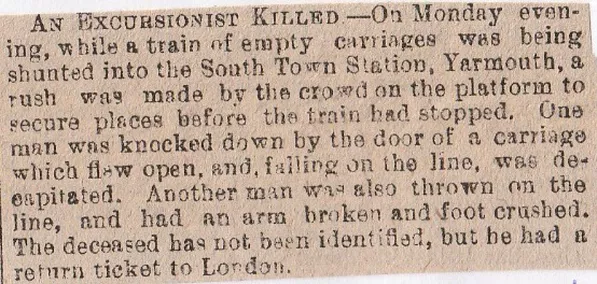
9/ Heacham near Hunstanton, April 1896 (Dog Owner Eaten by Spaniels)
An eccentric old woman who was said to belong to the higher echelons of society, but lived in a hut near the beach with only her four spaniels as company, was found dead in horrific circumstances. The woman firmly believed that her husband had drowned and his body would be washed up, hence the reason for her seclusion. The locals hadn’t seen her for a number of days and police went to investigate. They found she had died of starvation and her beloved to stay alive, had devoured her corpse. The face, arms and chest had all been eaten and even some puppies that were born were also eaten by the starving hounds. The animals were shot by police as they beared their teeth at the officers.
10/ Belton near Yarmouth, March 1872 (Railway Death)
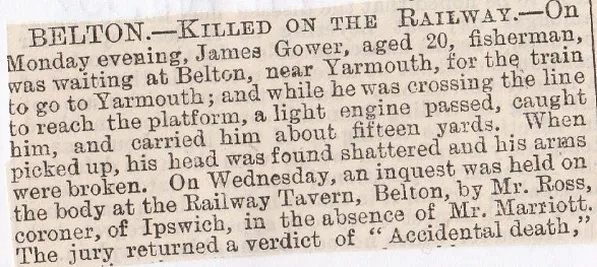
11/ Kings Lynn, May 1908 (Mistaken Identity)
A railway porter by the name of John Stork was involved in a remarkable case of mistaken identity. Stork vanished off the face of the earth, so his sister offered a reward for anyone who knew his whereabouts. A body was then found in a river near Outwell and the sister positively identified the body as that of her missing brother. She paid the reward and then attended the funeral with other relatives. John had been missing well over three weeks and the body looked quite fresh, so there was a doubt as to her identification of him. Meanwhile, another body turns up, found in the Ouse at Wiggenhall St Marys and the papers in his pocket verified the fact that he was the real John Stork. Whoever the first body was, has remained a mystery.
12/ Diss Infanticide, March 1851
A woman named Maria Clarke who killed her illegitimate son who was only six weeks old at the time, by burying him alive in a meadow near Diss in Norfolk. Clarke was committed for trial on the charge of the wilful murder of her son.
13/ Wymondham Suicide, March 1872
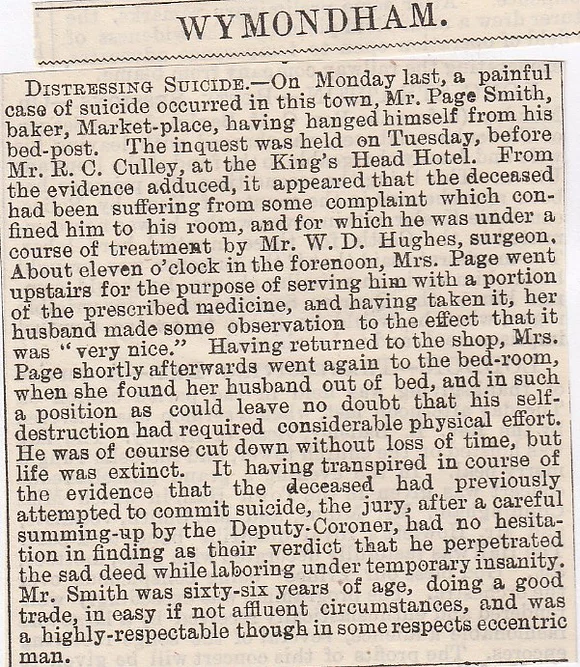
14/ Norwich Murder/Suicide, April 1908
A terrible accident occurred at Welbourne, a small village near Norwich. Ellen Smalls aged thirty-eight and the mother of kids was shot dead by James Green, her cousin, who afterwards committed suicide. Green had been locked up for quite a while, courtesy of Her Majesty’s prison service and it was because he threatened the woman that he was inside. Revenge was the motive then, as he held up the rifle and aimed at her head then pulled the trigger and blew her brains out. Neighbours heard the shot and rushed to the area and spotted Green legging it, but as he leapt over a wall into another field, another shot rang out and Green had shot himself in the head.
15/ Poringland Suicide near Norwich, March 1866
Twenty-two year old Miss Fransham, who kept her brothers house, a Poringland farmer, committed suicide by tying a piece of string to the trigger and then to one of her feet: she then placed the barrel in her mouth and tugging the string with her foot, the barrel exploded and took half her face away. She had been depressed of late.
16/ Hundred Feet Bank, March 1872 (Discovery of Body)
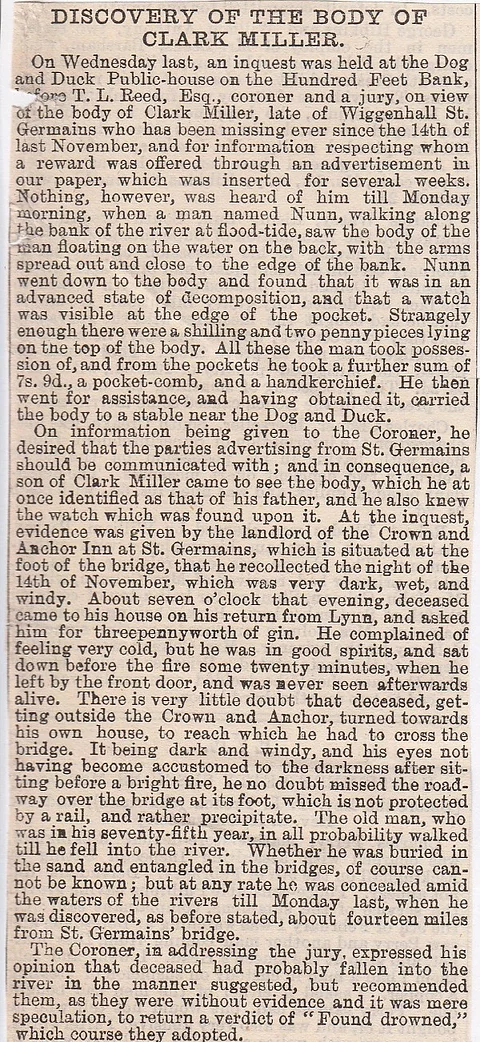
17/ Great Yarmouth Drownings, March 1885
Three men, named King of Norwich, Cullen, a gamekeeper and Cutts of Shotesham, were drowned yesterday by the capsizing of a boat near Yarmouth. They were returning from a coursing meeting.
18/ Caister Golf Club, April 1903 (Dead Golfer Found)
Benjamin Bratley, a golf professional at Caister Golf Club, was found decapitated on the railway near to the golf links. Bratley was supposedly run over by a late train on Thursday night.
19/ Watton Murder, November 1881
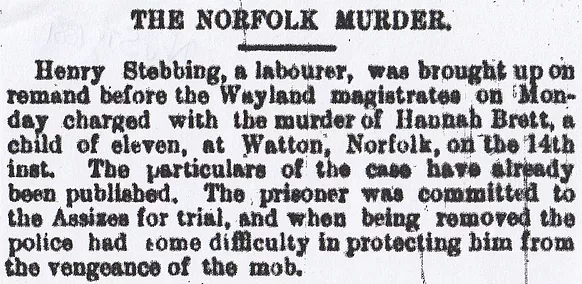
20/ Stokesby Murder, December 1900
The cottage of a woman named Kelly, whose husband had been in South Africa and died there from a disease while on active duty, was broken into by a man on Christmas Eve. She must have disturbed the burglar, then in the scuffle, he had stabbed her twice in the abdomen. He ran off and she was left there to die, but she was found and just able to speak. A few moments later she sadly died, so now police were on a murder hunt. One vital clue she gave before passing away was to lead police to arrest a nineteen-year-old labourer in the village, called Cossey. Kelly had a fourteen-week old daughter and was only thirty years old
21/ Stiffkey Wasp Death, September 1909
A well-known farmer and butcher in the area, John Massingham Mallett, died suddenly at his home at Stiffkey near Wells-next-the-Sea. He was sat in an armchair and was stung by a wasp, then he lapsed into unconsciousness and died shortly afterwards. He was an agriculturist and won prizes at the Brewers Exhibition in London, for best barley.
22/ Wormegay Murder, January 31st, 1885

Wormegay Murder, February 5th, 1885
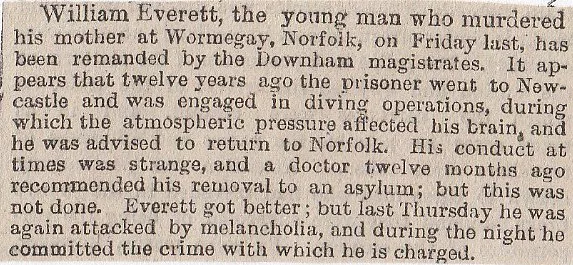
Wormegay Murder, February 17th, 1885
William Everitt, charged with murdering his mother at Wormegay, Norfolk on January 30th, has been pronounced insane and has been sent by the Home Secretary to Broadmoor Lunatic Asylum.
23/ Kings Lane at Lakenham, Norwich, February 1903
A young lad was on his way home to Kings Lane in Lakenham when he saw a girl lying on the ground with her throat cut. He ran to get the police but stumbled over a man at the end of the lane who had a fearful gash in his throat. They were taken to the hospital and the girl was pronounced dead on arrival. They were both identified later as boyfriend and girlfriend, Samuel Nelson aged twenty-three and an ex-soldier and she was Edith Fitt aged eighteen years.
24/ Swaffham, December 1904

25/ Stanfield Hall Murder, Norfolk, November 1848
James Blomfield Rush became the tenant of Stanfield Hall Farm in 1836 and when his wife died suddenly, he advertised for a governess. Step forward, Miss Emily Sandford. He took her back to the farmstead in Norfolk the had his way with her and promised to marry her. Now fast forward to 1848 and he was now in enormous debt and couldn’t afford the rent at Stanfield Hall Farm, so was evicted and slotted into another farm nearby, by the name of Potash Farm. Revenge was being hatched by Rush and he sort of blamed everyone else for his misfortunes and his main candidate for revenge was Isaac Jermy, who owned the Hall and had him turfed out of his farm.
Rush went out on the night of the 28th of November, 1848, and shot Jermy at the front of his residence. The butler ran to investigate as did his son, Isaac Jermy Jermy, and Rush again fired at him, killing him instantly. He also shot and wounded Jermy’s wife and a housemaid. Rush was identified as the murderer and arrested and hanged at Norwich Castle Hill in April 1849. The father was fifty-nine years old, and his son only twenty-seven, and were both buried at Wymondham churchyard.
26/ Norwich Murder/Suicide, January 1901
Samuel Dye was a thirty-seven-year-old labourer who was paralysed in both legs and confined to bed. Mrs Dye had to do some chores one morning and left Samuel in charge of the little one. When she went upstairs, she discovered them both dead with their throats slit. In Dye’s hand was the razor used to kill the child and himself.
27/ Swainsthorpe, Norfolk? 1883

28/ New Inn, Blakeney, May 1890 (Suicide Attempt)
Charles James, the landlord of the New Inn, Viney Hill, Blakeney, had a twenty-year-old daughter, Elizabeth, who tried to kill herself one morning. They all had breakfast together, then she ran across the orchard like Usain Bolt and headed straight for an old well they had. The mother saw what she was going to do and ran after her. Elizabeth pulled the covering stone off the well and just as her mother reached her she grabbed her by the hair, but in the struggle that followed, she wrangled herself free and fell into the well. A man named Milson James was lowered down on a rope to rescue her and this he did. She was brought out unconscious, but alive, and the same she was sent to a lunatic asylum. (The New Inn is still there at Viney Hill )
29/ Great Yarmouth Beach, September 1885 (Boy Buried Alive)
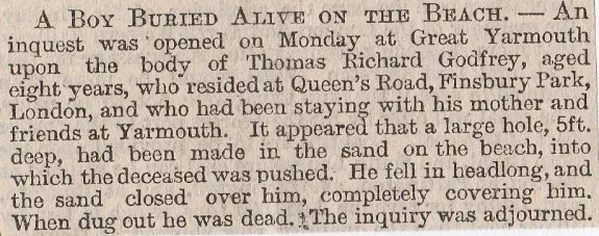
30/ Great Yarmouth, February 1898 (Attempted Murder/Suicide)
A man named Steel threw a woman named Maud Bensley out of an upstairs bedroom window, then attempted suicide. The way in which he murdered her is bordering on the psychotic, because he first slit her throat, so deep that it nearly cut the spinal column and then bashed her head in with a wrench then threw the body out of the window onto the ground below, dressed only in her nightdress. Steel then hid on the staircase and slit his throat three times. When police gained entry, Steel was still alive and put up a tremendous fight but he was taken to hospital where he is recovering well.
31/ West Walton Murder, September 1885
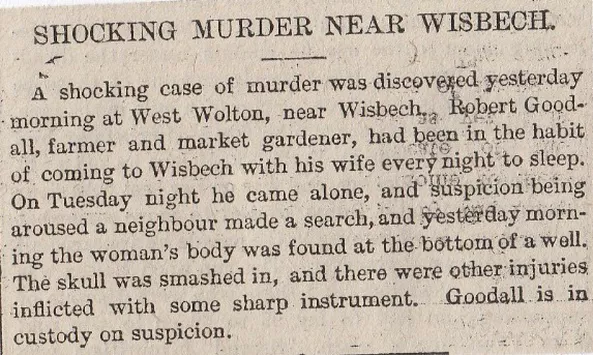
32/ Gorleston Beach Suicide, April 1910
A man by the name of George Jarvis Atherton aged sixty years and who had been unemployed for the best part of three or four months, decided to end his life. He got some prussic acid, telling the chemist it was to poison a dog. A very British suicide would be the way to describe this! He then went home, had a lovely dinner, then went to Gorleston Beach and swallowed the prussic acid. It was deemed “Suicide” by the jury and he’d taken six times more than was necessary to kill a man.
33/ Great Yarmouth Bridge Disaster May 2nd, 1845
Cooke’s Circus was coming to Great Yarmouth and for a piece of self-promotion, they thought that Nelson the Clown going down the Bure, while being pulled along by four geese would be a crowd-pleaser. Problem was, that too many decided to get a good view-point from the suspension bridge and when the clown and his geese came along, they were clapping and cheering, then it collapsed, sending hundreds into the river. The final death toll was seventy-nine dead.
34/ Norwich Murder, August 1886
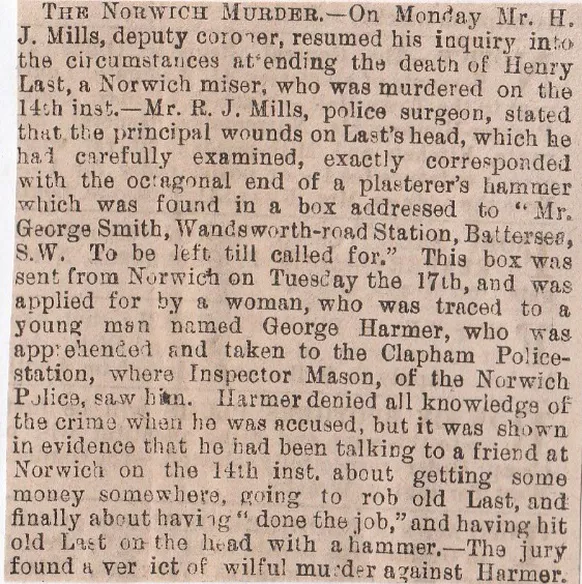
35/ Earlham Hall Fatality, Norwich, January 1901
The body of a fourteen-year-old boy, the son of Major Kerrison, was found in the surrounding parkland of Earlham Hall, Norwich. The lad shot himself in the head, as the revolver was still nearby, but although looking like suicide it was deemed an accident. He had gone for some shooting practice and then the tragic incident occurred.
36/ Saddlebow Fatalities, September 19th, 1885 (Not Saddleboat!)
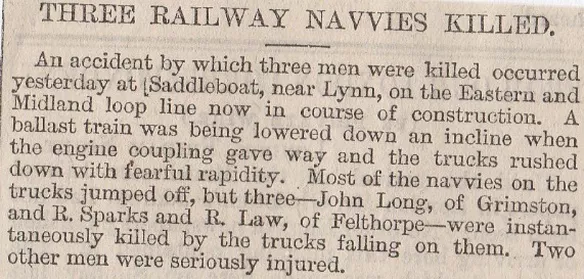
Saddlebow, September 21st, 1885
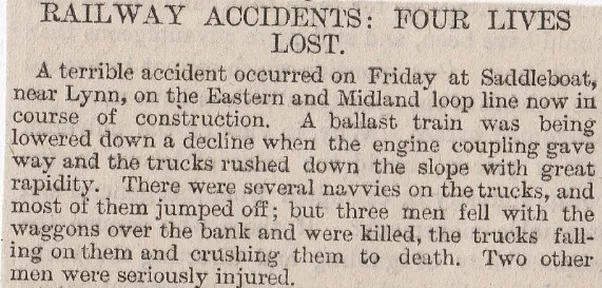
37/ East Winch Railway Station Fatality, September 1885
A fatal accident occurred at East Winch Railway Station, about nine miles from Swaffham. A groom at East Winch Hall, named George Johnson, was travelling by the express to Norwich, which stops at East Winch only on Tuesdays and when the train was passing the station, where it had been slowed down to 15-20 m.p.h., he leapt out. He was struck by the carriages and so severely injured that he died.
38/ Wells-next-the-Sea, October 1885 (Romantic Story)

39/ Great Yarmouth, May 1863 (Nelson’s Pillar Death)
Charles Marsh, a professional acrobat and his friend, Henry Wharton, decided to climb the 150 foot high Nelson’s Pillar at Great Yarmouth. Marsh had reached the platform near the top and tried to get onto the helmet of the figure of Britannia, when he slipped and fell, hitting the stone floor below and killing himself instantly.
40/ Jolly Farmers Inn, Watton, October 1890 (Singular Accident)
Mrs Semmence, the wife of the landlord of the Jolly Farmers Inn at Watton, fell down the stairs, and then in a million to one chance, she landed on the comb in her hair and the teeth stuck in her head. When a doctor was summoned and the comb fragments removed, the wounds were that deep, that Mrs Semmence’s nerves were shot to pieces and she passed away within a day of the accident.
41/ Norwich Hospital Murders, December 1875
A patient at the Norfolk and Norwich Hospital, Robert Edwards, went on a mad rampage in the children’s ward next to his, with a pair of fire-tongs and killed four young patients. A verdict of wilful murder was returned, but he was found to be insane and removed to Broadmoor Prison. (Is Hospital still there?)
42/ Caister Lifeboat Disaster, Norfolk, July 1885

43/ Norwich Suicide, April 1859 (Uncle/Niece Relationship)
This one is a bit disturbing, by the simple fact that a young lass by the name of Harriet Hostler killed herself because of a broken down relationship. Nothing weird there, you may think! The love letters explain that she was seeing her uncle, Nicholas Kaven. One of the letters reads:
“You are first in my thoughts in the morning and the last at night. My dearest girl, you must not keep me long waiting; I think you are very long. You shall not be long before you hear from me again and if you will favour me with one of your kind letters, you will oblige your affectionate lover.
Another section went as follows: “I hope you will meet me at the station, at six o’clock on Monday night. I shall be sure to come then. The greatest pleasure I have now is to hope to see your sweet face, my dearest. So no more for the present, from your affectionate lover, Nicholas Kaven.”
Harriet took some laudanum to end her days and that was down to Kaven promising to marry her, then him backing out. The verdict was”Deceased committed suicide by taking laudanum, which was taken in an unsound state of mind, produced by the villainous conduct of her uncle, Nicolas Kaven.” (Weird!!)
44/ Mattishall Burgh, August 1848 (Child Tied to Cow)
Two ladies were riding down a lane in Mattishall Burgh when they spotted a cow running towards them and a child tied to its tail. They went to the nearest house and got help to stop the beast. Unfortunately, the child was already dead. His body was bruised and lacerated all over. A witness said that the deceased, a ten-year-old lad named Thomas Ireson, had tied the tail around his body, but then the cow had sped off, carrying him with it. Verdict of “Accidental Death.”
45/ Norwich Gaol, December 1885 (Execution goes wrong)
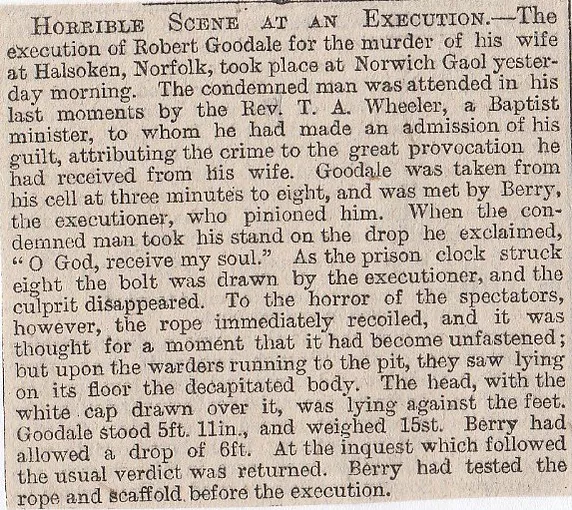
46/ Belton Suicide, Yarmouth, October 1889
A woman named Burrage left her home in Belton near Yarmouth on Saturday with her newly born child, and then threw herself in front of a train on the Great Eastern Railway and was cut to pieces. The child escaped.
47/ Norfolk Coast, January 1885 (Barque Capsizes)
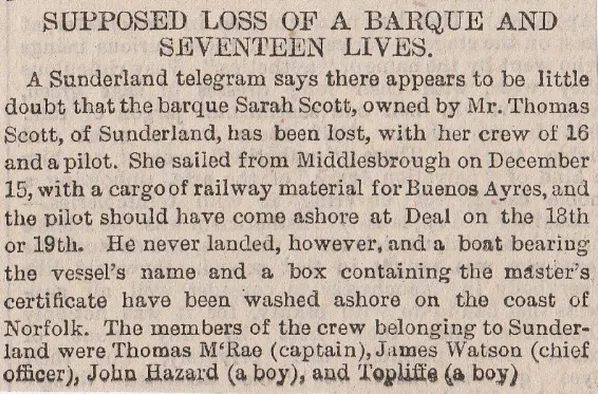
48/ Kings Lynn Football Fatality, November 1896

49/ Yarmouth Boating Deaths, August 1870
This afternoon Mr George Bussey, of South Market Road, Great Yarmouth, with his wife and child, and Mr Peter Jensen, a commercial traveller from London, who had also with him his wife and child, proceded for a sail in a pleasure boat. About two miles from Yarmouth their boat came in collision with a wherry and was capsized. The two gentlemen were carried off by the current and drowned. The ladies and children were saved by another boat.
50/ Norfolk Child Murders? ( Kings Lynn/Hainford) December 1870
51/ Fakenham Railway Suicide, December 1870
An inquest was held at Fakenham, on the body of William Brown, a youth who committed suicide on the Great Eastern Railway. Deceased was in the service of the Rev.M. Atkinson, rector of Fakenham, and Mr Atkinson had reproved him for improper behaviour at church and inattention to his duties. These rebukes seem to have weighed upon his mind, and on Monday afternoon he threw himself before a train and was cut to pieces. The jury returned a verdict to the effect that deceased destroyed himself while in a state of temporary insanity.
52/ Yarmouth Manslaughter, December 1870 (At the Bush Tavern, South Quay)
53/ Corpse Lay in Bed for 50 days, Norwich. February 1867
54/ Yarmouth Boating Fatality, February 1866 (Three Drowned)
55/ Explosion at Walsingham Church, November 1866
56/ Kings Lynn Manslaughter/Murder? February 1867. (Attacked at Queen Street, Kings Lynn)
57/ Gorleston Lifeboat Disaster, January 17th, 1866.
January 23rd, 1866.
Yesterday a meeting was held at the Corn Exchange, Great Yarmouth, for the purpose of considering the best means of affording relief to the nine widows and twenty-four children left destitute by the late lifeboat disaster at Gorleston. £70 had been collected at the local banks, and £11 had been collected at Hopton Church. Sir E.Lacon M.P., sent a donation of £25. About £300 was subscribed before the meeting broke up.
58/ Norwich Explosion Kills Seven Men, October 1866
59/ Norwich Murder/Suicide, March 25th, 1867
March 26th, 1867.
The old man John Winter, who is supposed to have murdered his wife at Norwich, on Friday, subsequently inflicting frightful wounds upon himself, died on Sunday from the injuries he sustained. He died in the Norfolk and Norwich Hospital. He was from the first greatly enfeebled from the loss of blood and was able to speak very little. He was then attended by three clergymen, and one of them asked if he was sorry for what he had done. The old man answered in the affirmative. An inquest will be held on his body, and the adjourned inquest on the body of the murdered woman will also be resumed on Tuesday. The death of Winter, however, obviously deprives the proceedings of any further interest.
60/ “New Skylark” Boating Tragedy, Great Yarmouth. October 3rd, 1903. (The steamer “Birma sliced the New Skylark in two, causing six deaths. The Skylark lost three crew, James Sutton, Arthur Beckett and George Shreeve, plus three passengers, with seven trippers rescued)
October 6th, 1903. (The Judgment of the Court of Inquiry)
61/ Tried Twice For Murder of Husband, Norwich. June 23rd 1906
July 24th, 1906 (Rosa Kowen Goes Mad)
Mrs Rosa Kowen, of Norwich, who was twice tried for the murder of her husband, the jury disagreeing on both occasions, has been committed to an asylum. Since her release from Norwich Gaol she had been acting strangely and in consequence of an accident which occurred last week, some friends in London with whom she had been staying, decided to have her placed under restraint. Mrs Kowen has since been moved to London County Council asylum.


